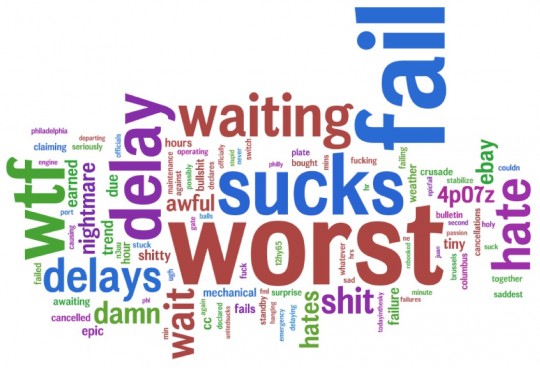Love/Hate: Why Disliked Brands Prosper
Something brand owners strive for is that elusive magic of being loved by consumers. Brands like Apple, Google, Southwest Airlines, and others have earned enduring positive regard among consumers, and those companies outdo their peers in part because of the brand equity they have built. But what about brands people don’t like? Oddly, some of those survive quite nicely and even prosper.
Supermarkets
A recent study by Consumer Reports used customer opinions to rank grocery chains, and Walmart came in almost dead last; only Pathmark was more reviled by shoppers. Consumers favored Wegmans, Trader Joe’s, Costco, and others. Nevertheless, the giant company is the biggest and busiest chain in the U.S., while the most-liked companies (Wegmans, Trader Joe’s, and Publix) have a much smaller footprint.
Airlines
Airline brands are some of the most despised these days, with much of the damage self-inflicted. Cramped seating, fees for previously included services, fewer amenities, and a general lack of customer-orientation characterize the big airline brands today. This word cloud was created by Brian Solis and featured in his book, The End of Business As Usual: Rewire the Way You Work to Succeed in the Consumer Revolution, Brian Solis displays what people were saying about a major airline in social media:

You would think that any company with that kind of brand image would see rapidly declining sales and loss of market share. We don’t know WHICH major airline sparked this negative commentary, but all of the major lines are more or less holding their own.
I added my own tweet to American Airlines’ odiferous cloud just hours ago after being informed I couldn’t stand by for an American flight an hour earlier than the one I was booked on. Why not? I wasn’t a “gold” or “platinum” customer. That’s a heck of a way to build a brand… Why not empower the employee at the gate to fill an empty seat on a departing plane and, at the same time, make a weary business traveler happy? That concept isn’t in American’s DNA, it seems, and that’s how companies build tag clouds like the one shown above. (My contribution: “Why does @AmericanAir prefer to fly an empty seat vs letting a non-elite biz passenger standby? #FAIL #dumb”)
Pragmatism Over Preference
There’s a simple explanation for how brands people dislike endure: consumers will continue dealing with a brand they don’t like if other advantages are significant. Factors like price, convenience, and simple availability are big factors in many consumer decisions. People will tolerate bland stores and mediocre service at Walmart if they think their grocery bill will be ten or twenty bucks cheaper. An article by Allison Linn at msnbc.com offers quotes from readers:
“Love Trader Joe’s, Co-op, Whole Foods, etc. but low price comes first.”
“Luv/Hate with Walmart. We are disabled and on a fixed income — go to Walmart for prices but hate the store.”
Similarly, people will fly United, American, or Delta if better airlines can’t offer comparable availability and pricing. As a frequent business traveler, I’d fly JetBlue every trip if I could, but I can’t. They serve a limited number of cities with a limited number of flights. Even if I’m headed to a city they serve, timing or seat availability may prevent me from using them. Other times, their price is a lot higher. From a business standpoint, I can’t justify major differences in departure/arrival times (or massively higher prices) just to satisfy my brand preference. If an airline I prefer doesn’t have a reasonably competitive offering, I grit my teeth and book the flights on one of the poor-service carriers.
The Danger in Being Disliked
If companies like Walmart and United Airlines can survive for years while selling to customers who dislike them, should brands focus just on building advantages like lower prices and greater availability and not worry about brand perception? That’s not the lesson one should draw from this. Southwest Airlines, a brand with a very positive image among consumers, is the only carrier to stay profitable in recent years. The other lines have been plagued with one or more bankruptcies even as they held onto market share.
The biggest danger in ignoring brand perception (as the airlines seem to do, rarely responding to customer feedback in social media) is that brand loyalty will be zero if a viable competitor emerges. I may be stuck with American Air when I fly in Texas, but I don’t have to shop at Walmart. Individual stores vary, but the closest unit of Texas-oriented HEB offers more pleasant stores, more helpful people, better products, and very frequent sampling of food and wines. Going to this HEB is about as pleasant an experience as any grocery shopping trip can be, and I have no desire go to Walmart or even the more upscale (and equidistant) Randalls. Now, Whole Foods is opening a unit almost next to HEB; while I’ll likely shop there occasionally, I suspect HEB will continue to dominate my grocery spend.
Over time, most brands will need to meet competitive challenges, and a positive consumer image needs to be one of them. Nokia dominated the cell phone business, but that happened more because they had the products people wanted and great distribution. Few people had a warm spot in their heart for Nokia the way they might for, say, Apple. As other makers introduced products that were more relevant to consumer needs, Nokia had no brand momentum and got crushed.
In the short run, products and price can win the game. In the long run, a positive brand image can fend off competitors that emerge with comparable or even slightly better offers. Branding alone won’t carry a company forever, but it may keep it in the game long enough to regain its competitive edge. Conversely, consumer dislike for a brand is like cancer: it may not kill you right away, but unless you treat it your long-term prognosis is poor.
